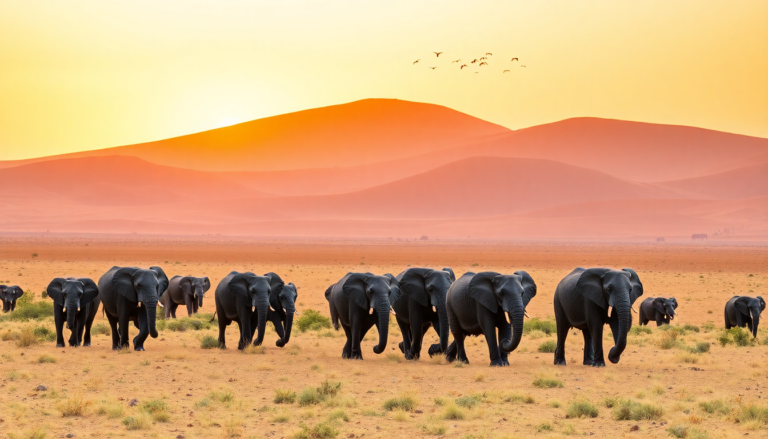Argomenti trattati
Some travels are not just about reaching a destination; they resonate deep within us, altering our very essence. A safari in Namibia is one such experience—an intimate encounter with nature in a country that has woven environmental protection into its very fabric. With over 40% of its land under conservation or sustainable management, Namibia is a testament to a young Africa that cherishes its unique biodiversity. Choosing Namibia means embracing a form of tourism that respects the land, listens to its rhythms, and honors its people.
Etosha: A vast white expanse of life
Just the name ‘Etosha’ conjures images of surreal landscapes and thrilling wildlife encounters. Located in the northern part of the country, this colossal national park—spanning over 22,000 square kilometers—stands as one of Africa’s premier safari destinations. The term ‘Etosha’ translates to ‘great white place’, aptly describing its vast salt pan, which transforms into a dazzling desert during the dry season, resembling a lunar landscape of shimmering crystals and pale dust reflecting the sky.
When the dry season grips the region, life clusters around the precious waterholes scattered throughout the park. Here, primordial energy radiates as giraffes, elephants, springboks, black and white rhinos, lions, leopards, and even flamingos share this incredible space, creating a spectacle that feels almost miraculous. Sure, you’ll notice the absence of buffalo, but the diversity of species here is astounding. One can hear the stealthy footsteps of cheetahs, the cackling of hyenas, and the rustling wings that break the stillness of the air.
Damaraland: A land of ancient memories
Next, we venture into Damaraland, nestled between the Namib and Kalahari deserts. It beckons visitors to listen, to marvel, to embrace the silence. The landscape here is ever-changing, from sandy plains to rocky hills, wind-carved canyons, and sun-drenched savannahs. This territory holds ancient memories—rock paintings and engravings whisper tales of a primordial humanity, while the fauna showcases impressive adaptability.
The undisputed ruler of this rugged terrain is the desert elephant, a gentle giant that has evolved to thrive in this environment, sporting broader feet and a more deliberate gait. Encountering one of these magnificent creatures (always under the watchful eye of a knowledgeable guide) is a moment that leaves you utterly speechless. But Damaraland has more to offer: mountain zebras, solitary giraffes, and oryx antelopes vibrant against the red hills. And let’s not forget the elusive black rhino, a shy and precious symbol of the fragility of our natural world.
Cape Cross: The wild side of the ocean
Where the desert kisses the ocean, you’ll find Cape Cross. This strip of land along the Atlantic coastline is home to one of the largest and most lively colonies of Cape fur seals. It’s an unexpected destination where the roar of the waves mingles with the raucous cries of thousands of animals. Throughout the year, this area is inhabited by 80,000 to 100,000 seals, but between October and November, adult males return to stake their territories, heralding the breeding season. The spectacle is powerful, overwhelming, and primal—a raw dance of strength and survival unfolds before those who watch with respect.
Walking along the boardwalks designed to observe the seals without disturbing them, you can inhale the strong, salty scent rising from the sea while witnessing pups being born and wobbling uncertainly among their parents. This experience deeply connects you with nature’s cyclic rhythm.
Namib Desert: A timeless wonder
In Namibia, time flows differently. The dunes—tall, sinuous, and ever-shifting—change hues with the light, transitioning from deep red to golden, and finally to the almost surreal white at dawn. This is the oldest desert on Earth, a landscape that feels otherworldly yet is sculpted by the wind along Namibia’s western coast. Plants like the Welwitschia mirabilis, with its twisted leaves, have adapted to live for up to 2,000 years, drawing moisture from ocean fog. Camouflaged geckos, astonishing insects, and reptiles that absorb humidity directly through their skin all tell a tale of resilience.
Among these dunes, larger creatures roam as well—ostriches, brown hyenas, and solitary cheetahs stealthily hunting across the sands. (I remember the first time I spotted a cheetah in the wild; it felt like witnessing a secret performance of nature, raw and unfiltered.) The Namib Desert is not just a collection of stunning vistas; it’s a living testament to the beauty and harshness of life, a place that challenges and inspires.

